“We did not create our advertisements in order to provoke, but to make people talk, to develop citizen consciousness,” Luciano Benetton assures us. Whether or not they began in this way, many Benetton advertisement campaigns have ended with controversy. In the Autumn of 2011, with the launch of the unHate campaign, some of the photographs in the series wouldn’t see a full day on the billboards. It is by this light — the light of controversy — that I consider each advert. It must be acknowledged that such campaigns do wonders for the company: a political alignment with consumers is much stronger than a strictly aesthetic one, after all. Nevertheless, given that such projects have enormous visibility, there is a logic in the highly politicized propaganda. I believe this is the classic win-win situation. We shouldn’t whine about that.
10. This one’s for the fridge
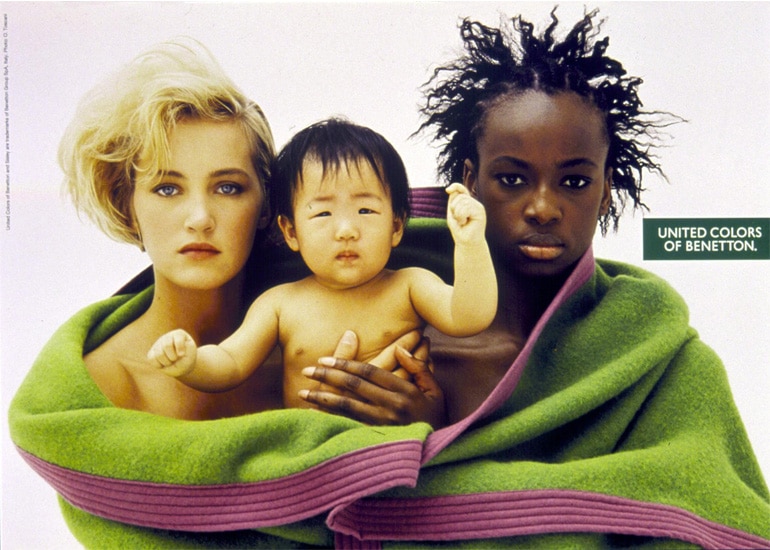
This 1991 ad is much more than meets the eye. Sure, there’s the typical message of unity: one figure from three historically conflicting continents all being warmed by a single blanket. Looking closer at the image, you see that the women on either end of the child have their hands clasped together (which would probably explain the colors used for the blanket) and suddenly the image becomes a family portrait. The power of this advert is its subtlety and refusal to submit to any homosexual stereotypes or restrictions in terms of interracial love or the issue of adopting.
9. Whoa, whoa, what’s important!
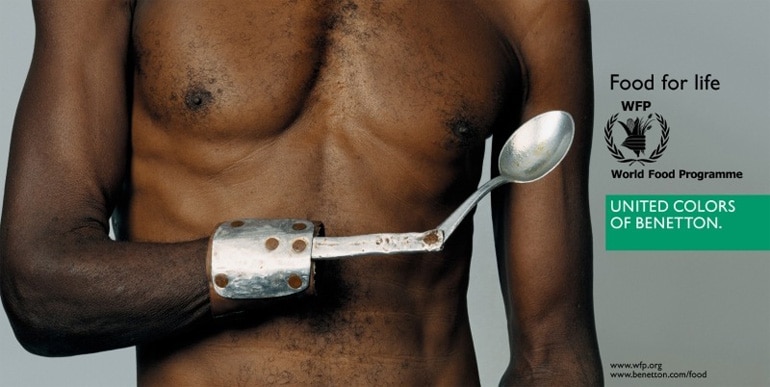
Benetton takes on a different issue in 1997, fighting world hunger through its support of the World Food Programme (WFP). Portrayed above is the most startling of the images; it depicts, in an entirely unique way, how hunger can consume the body (no starving bodies here, just spectacular symbolism). I would have put this ad higher up on the top ten if it weren’t for the natural no-brainer nature of the subject being tackled. World hunger is understood by all to be a grave issue — even if it doesn’t figure in the everyday life of most that would come by glossy magazine advertisements. Benetton will prove itself to be capable of much greater controversy!
8. Ebony & Ivory

Here’s an image to be studied. Luciano Benetton, the hero of this list one might say, meets a photographer, Oliviero Toscano, in 1982 who shows him that a focus of message over product could be more effective. In that year, Toscano creates the above work. Vaguely Blakean in its Romanticism, two innocent young girls — one white, one black — embrace one another. But are they really as innocent as each other? There seems to be an imbalance. The girl on the left has the hair and cheeks of a cherub, of an angel. The other girl has her hair spiked up like devil horns and resists a smile. Although attempting a “uniting” effect, the ad fails in its racist shortcomings, separating colors into good and evil.
7. Sentenced without words
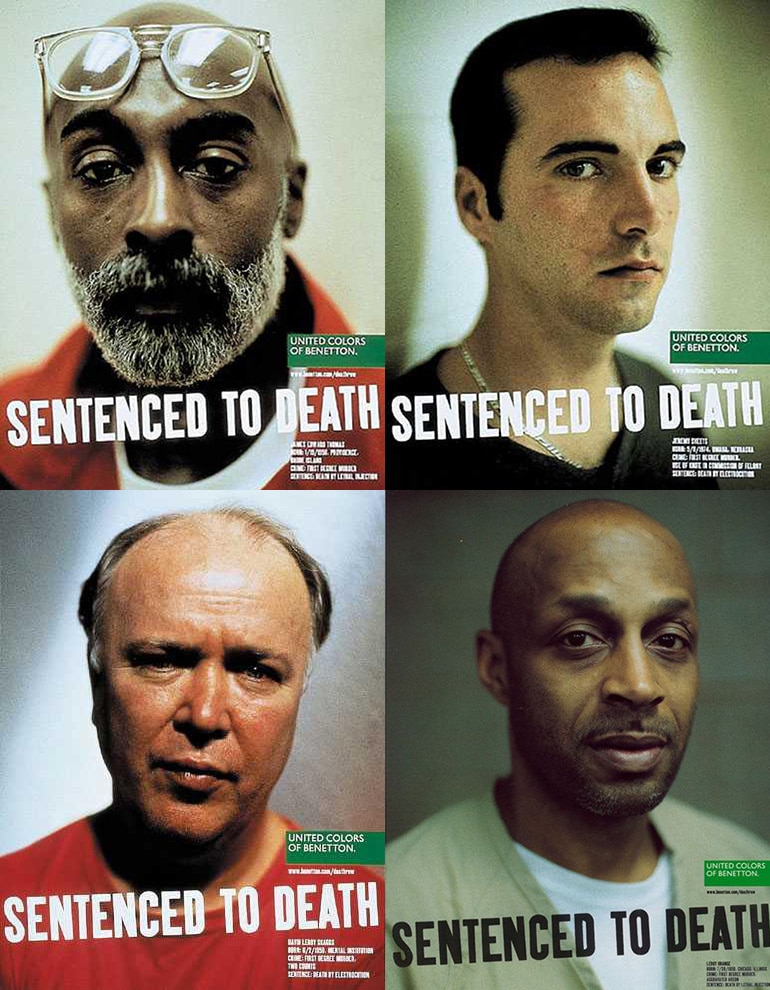
Nobody saw this one coming. 1996 marks a challenge to capital punishment, a subject much more contestable than any we’ve seen to date. The idea of using convicted criminals as models for a high-end fashion label isn’t the first to come up at a board meeting. Essentially, this is yet another outlet for their pro-life message: suffer at all costs, just don’t do the wrong thing by taking life away. While consistent, there is a bizarre leaning towards a defense of violence (although involuntary) which weakens the effectiveness yet raises the bar of controversy.
6. unPreservable

What’s colorful, mass-produced, and fun? It was only a matter of time before Benetton saw the link between their line of clothing and condoms. Influenced by the Olympics in Barcelona the preceding year, the 1993 ads brought color to the AIDS pandemic. This was just over a decade after the formal recognition of the disease; when it was still charged with ideas that it was cleansing society of the undesirables. Benetton bravely uses HIV positivity to create lively, sexy images — a perspective very unlike traditional representations of AIDS as death itself. As we will shortly see, they will play on this trope more controversially.
5. An odd bouquet
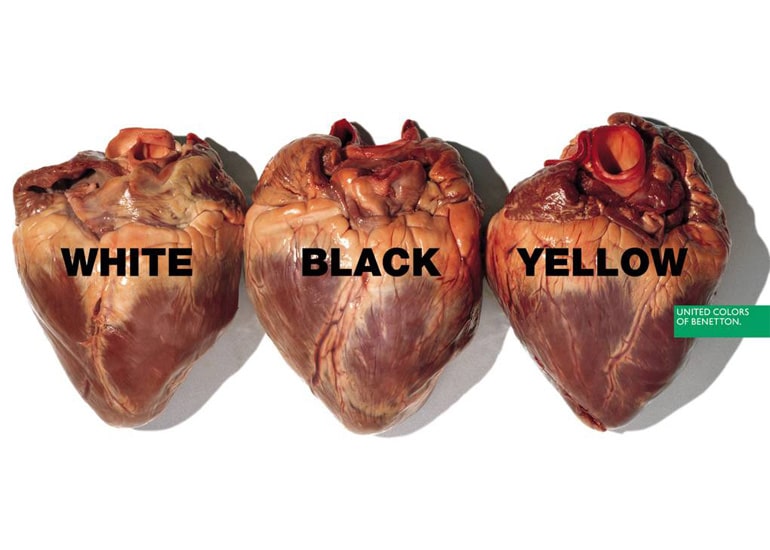
The next image takes the eroticized body of number 6, above, and changes the corporeality to its essential value: the inner body, the organs. In the consistent message of love, which organ should be chosen but the heart? This echoes the words of none other than Shakespeare: If you prick us, do we not bleed? On the inside, we are all the same, white, black, yellow (although we might argue that these are contestable titles). The clinical grotesqueness of the hearts is married to their poetic value as pseudo-roses, side by side. They inhabit a space between ugliness and beauty, between violence and peace.
4. Fear and clothing in L.A

Using iconic images from the recent news of horrors that still haunt the millions is insensitive. Very often, insensitivity is effective. The car bomb image at the left, for example, treats the issue of terrorism from an observational perspective, as if saying that the brand is still relevant to today’s issues and that some issues cannot be considered as simple as we have seen to date. How could you fit the message of love into this, after all? But to be clearly observational is to be reductionist. The images as controversial precisely because they can’t make up their mind on any of the issues they try to tackle, yet still, try to sell clothing by means of them.
3. Red to your head
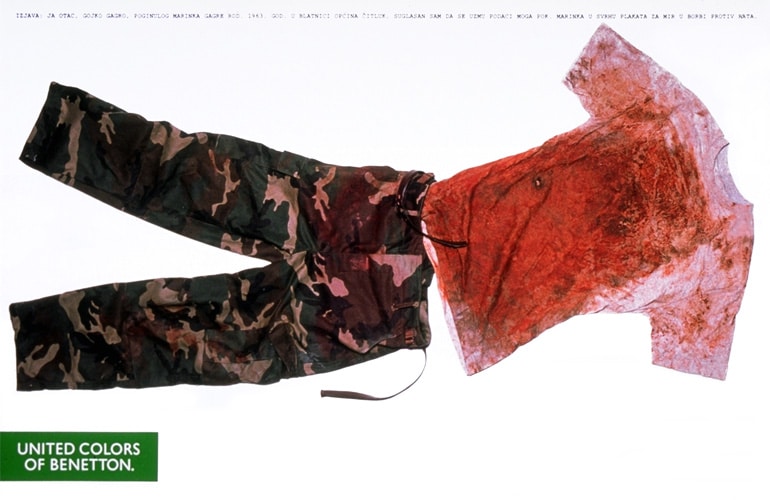
In the last entry, there were public pictures — although terrifying — that belonged and deserved to be in the public sphere. In 1994, Benetton takes the uniform of a fallen Bosnian soldier brutally wearing its red (the most uniting color of all, no?) and bullet holes. This was conveniently at the height of the war’s presence in western media where it became the issue of human rights with its thousand-fold complications. It is no wonder that Benetton was attracted to it! Interestingly, this is the only ad to make it on the list that features primarily clothing (not of their company of course, but clothing never the less).
2. Baby, we’ll get through this
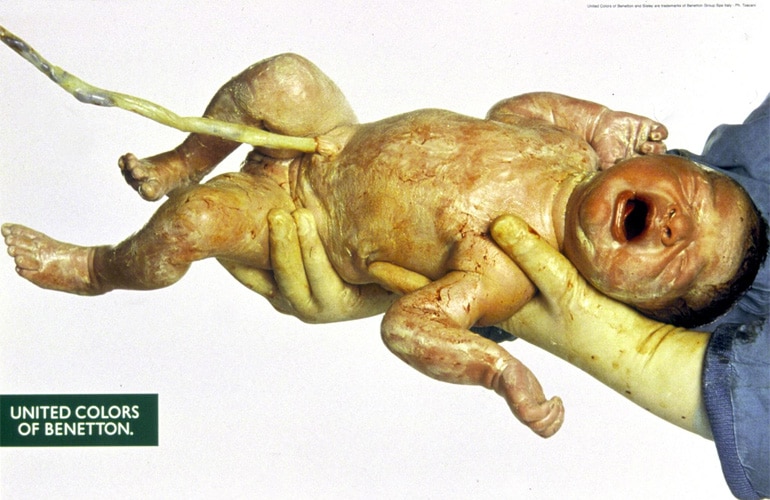
A birth, the symbol of life. That is the instant value of this image. It is about as brutal as anyone would care to have it, representing childbirth in a much truer fashion than most films. But the pains of first breath is just the beginning: this is another image from the 1993 AIDS campaign. A child born into illness and death becomes one of the most discomforting images ever to grace the billboards.
With the umbilical cord still intact, the baby lays in a premonition of the grave. Child deaths from AIDS are still prevalent. In 2007, it is estimated that there were 330,000 infant deaths on account of the disease. It is important to face the truth, and its worth is greater when appearing in an unexpected place such as advertising space.
1. Face to face

The simplicity of this gesture, a kiss, in comparison to many of the aggressive notions in the ads we have seen to date shouldn’t be able to incite such strong reactions as it does. The choice of Pope Benedict XVI and imam Sheik Ahmed el-Tayeb profoundly makes an argument for reconciliation (elsewhere, other world leaders are chosen). Just hours after being put up, Benetton was required to take down this advertisement and apologize to the Vatican, who are taking legal action.
The unHate series marks the enunciation of a new political position, which had already been hinted at. Rather than love, that can fail us sometimes, a message of unhate (like a child’s rendition of the term) continues with their earlier political positions while encompassing the present issues. For this reason, and the upstart reaction, it deserves the highest spot on our list. Spread the message of unHate!
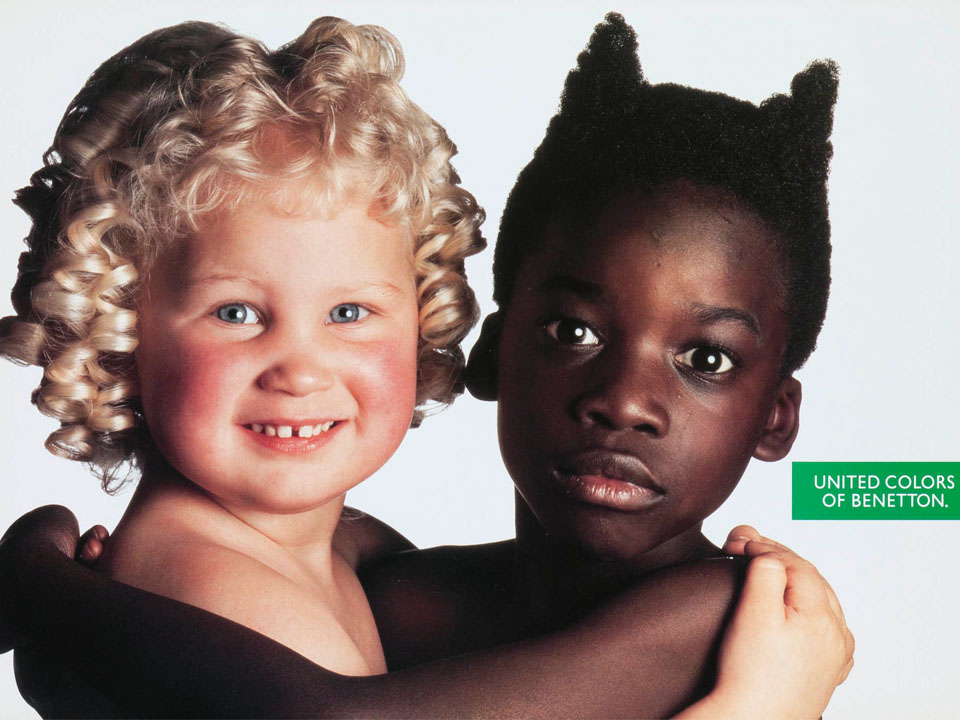
I would say that whatever your description of failure or controversy here is, the idea of message above goods and Toscani’s execution of this idea is absolutely amazing and the best we have in our PR’ reality.
Any retailer will tell you that it’s about the bottom line. The death penalty inmates helped destroy the brand in the USA – and rightfully so.
Well, I grew up in West Africa in the 80s and we didn’t think they were racist ads. Stop being so negative.
You might be interested in this guy called Tibor Kalman who is well known for his work as editor-in-chief of Colors magazine. The image of ‘Baby, we will get through this’ was used as a Benetton campaign on billboards – super-powerful as well. So it was a Benetton campaign that at the same time was selling Colors, and Colors selling Benetton. It was the idea of moving communication onto another level, taking corporate communication onto a meaningful level. (Reference : interview from Designer Fernado Guttierbez)
Where is the Theresa Frere pic?
Many of these ads send a POWERFUL message… Those who are so put out, and offended by them simply need to REPROGRAM their way of thinking, and, by the way, GET A LIFE.
Yeah, let’s keep hatred and racism going, right? Who are you? A KKK member, or member of another hater group? When most of the planet is working towards tolerance, there come ignorant people to pull the world backward – into the dark ages.
Dark ages never end. Tolerance and intolerance are just ways to organize meals for cannibals, to extract living energy from others and even waste them. Those ways are numerous. Your thoughts of the most of a planet work are really utopian.
Surely it is brave for a fashion brand to be so provocative… we’re all the messages politically correct? No! Did they create dialogue and shift perceptions? Compare this to McD trying to tell you their food is healthy because u can get fruit slices instead of chips/fries? Which should we condemn and which should we praise?
KKK members are just naive fools thinking they can save anybody at all.
Great to see the white European subconsciousness erupting into this ugliness. The racism, the hatred for those cultures and peoples it destroyed through the colonizing process was not enough, so the destruction of the other continues in ads. What f****d up a world we live in.
… And you still wondering, oh professor! Huh! Ways of hatred are and have been so versatile even among Africans themselves, as well as among white or any others, racist, chovinistic or any other ways! Would there be any way to eliminate hatred if people can’t even leave each other on their own but, on the contrary, seek ways to devour each other!? The world is lost from its very beginning, all races, all nations, all tribes, all families, all people, all living creatures eventually live in struggle, rivalry, and conflicts, all the elementary particles… Everything that exists. No existence – no hatred. This world is satanic in its inner nature, its a wretched ugly circus, a deceitful playground. Should we think of suicide just on the basis of a racial issue?
During these times as South African the advertiser made the authorities run for cover as in the 80 s we still had apartheid in RSA so the National Party was in trouble, as a result, the adverts helped to put pressure on the regime. Viva United Colors of Benetton!
Absolutely. People who never lived under racism/apartheid, will never understand Bennetton ads.
This Nr 3. was a uniform of Croatian Military Defence soldier.
I am a white looking black European 50-year-old female, I have seen it and heard it all when it comes to racism in daily life since I was a child… it has been so hard being a “race spy” my life long so far. My heart was broken every time someone shared with me his/her disgust and rejection for my brothers and sisters without knowing I was also black. So very sad. Yes, racism exists still today.
The type of reclaim are shown is very important to our world, and its functions.
Show some poor man dying of aids or a baby just been born. Could you please tell me what on earth any of that has to do with selling clothes.
It would be great to see an American Brand support the Ukraine like Benetton did for the Bosnians. It is a shame to see how cowardly US Firms and leaders have become to not have Nike, Apple or ben and jerry stand for Democracy like in the Ad #11 above.
By taking a stance on moral or political issues what they’re actually doing is alienating the customers who don’t agree with their stance. Businesses exist to sell products, not to make political statements. And even then, they are exploiting the political statement just to sell their products. If it was truly about altruism or just pure political belief, they wouldn’t need to put their name to it – virtue is only truly virtue without witness and without reward.
Get over yourself, “Michael.” They could still sell clothes without these ads. They choose to make political statements and challenge the way we divide racially and they have every right to do so. If you can’t handle it, go elsewhere.
I saw the 1990 HIV picture when it came out. I have never forgotten it. What a powerful statement without using a word.